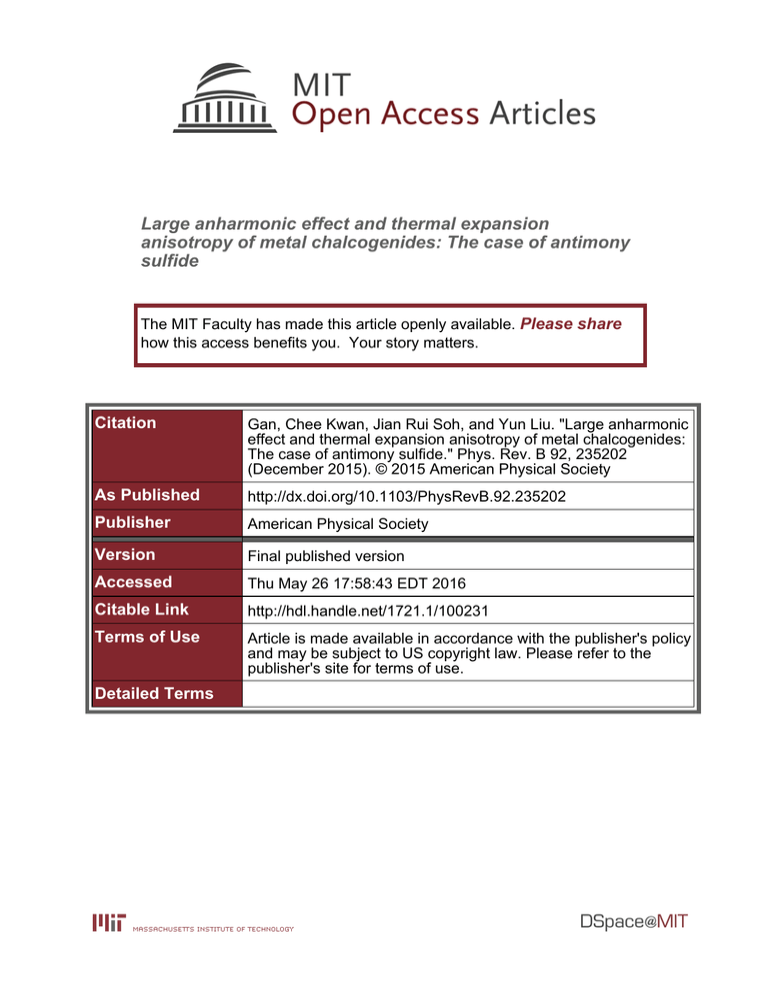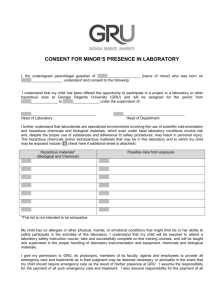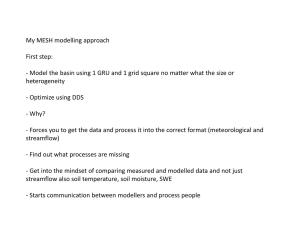Large anharmonic effect and thermal expansion sulfide
advertisement

Large anharmonic effect and thermal expansion
anisotropy of metal chalcogenides: The case of antimony
sulfide
The MIT Faculty has made this article openly available. Please share
how this access benefits you. Your story matters.
Citation
Gan, Chee Kwan, Jian Rui Soh, and Yun Liu. "Large anharmonic
effect and thermal expansion anisotropy of metal chalcogenides:
The case of antimony sulfide." Phys. Rev. B 92, 235202
(December 2015). © 2015 American Physical Society
As Published
http://dx.doi.org/10.1103/PhysRevB.92.235202
Publisher
American Physical Society
Version
Final published version
Accessed
Thu May 26 17:58:43 EDT 2016
Citable Link
http://hdl.handle.net/1721.1/100231
Terms of Use
Article is made available in accordance with the publisher's policy
and may be subject to US copyright law. Please refer to the
publisher's site for terms of use.
Detailed Terms
PHYSICAL REVIEW B 92, 235202 (2015)
Large anharmonic effect and thermal expansion anisotropy of metal chalcogenides:
The case of antimony sulfide
Chee Kwan Gan* and Jian Rui Soh
Institute of High Performance Computing, 1 Fusionopolis Way, 16-16 Connexis, Singapore 138632
Yun Liu
Department of Materials Science and Engineering, Massachusetts Institute of Technology,
77 Massachusetts Avenue, Cambridge, Massachusetts 02139, USA
(Received 10 September 2015; published 2 December 2015)
We derive a compact matrix expression for the linear thermal expansion coefficients (TECs) for a general
orthorhombic system which relates elastic properties and integrated quantities based on deformation and mode
dependent Grüneisen parameters and mode dependent heat capacities. The density of Grüneisen parameters
(ν) as a function of frequency ν, weighted by the number of phonon modes, is introduced and found to
be illuminating in interpreting the TEC results. Using density functional perturbation theory and Grüneisen
formalism for thermal expansion, we illustrate the general usefulness of this method by calculating the linear and
volumetric TECs of a low-symmetry orthorhombic compound antimony sulfide (Sb2 S3 ), which belongs to a large
class of technologically and fundamentally important materials. Even though negative Grüneisen parameters are
found for deformations in all three crystal directions, the (ν) data rule out the occurrences of negative TECs
at all temperatures. Sb2 S3 exhibits a large thermal expansion anisotropy where the TEC in the b direction can
reach as high as 13 × 10−6 K−1 at high temperatures, about two and seven times larger than the TECs in the c
and a direction, respectively. Our work suggests a general and practical first-principles approach to calculate the
thermal properties of other complicated low-symmetry systems.
DOI: 10.1103/PhysRevB.92.235202
PACS number(s): 63.20.D−, 65.40.De
I. INTRODUCTION
Metal chalcogenides comprise an important class of semiconductors for optoelectronics, photovoltaics, and thermoelectrics [1–5]. Recently, Raman spectroscopies and pump
probe experiments on examples such as Bi2 S3 and Sb2 S3
have demonstrated the importance of phonons in modulating
fundamental scattering processes [5,6]. Even though phonon
dispersions have been reliably obtained for some of these
materials [5,7], a first-principles study of the anharmonic
effects due to phonon-phonon scatterings that account for
thermal conductivities and thermal expansion coefficients
(TECs) has been lacking. This could be attributed to the fact
that metal chalcogenides have a relatively large primitive cell
and a low-symmetry orthorhombic structure with three lattice
parameters, in contrast to some of the well-studied cubic
structures with a single lattice parameter [8,9]. TECs may
routinely be calculated using a direct minimization approach
within the quasiharmonic approximation [10]. However, for
metal chalcogenides, huge computational costs are needed
to perform many phonon calculations to locate a free-energy
minimum at a given temperature in the three-dimensional lattice parameter space. Moreover, even if a direct minimization
approach could be carried out, it may be difficult to understand
the underlying physics without investigating fundamental
quantities such as the Grüneisen parameters, elastic constants,
heat capacities, and mean-square displacements (MSDs).
Here we should mention a recent first-principles approach
that is based on the vibrational self-consistent-field to calculate
TECs [11]. In another work [12], a nonequilibrium Green’s-
*
Corresponding author: ganck@ihpc.a-star.edu.sg
1098-0121/2015/92(23)/235202(4)
function method is used to calculate TECs of carbon nanotubes
and graphene with a force-field potential.
II. METHODOLOGY
In this paper we adopt the Grüneisen formalism
[13–15] to predict the thermal properties of a low-symmetry
orthorhombic system with a first-principles method. To the best
of our knowledge it is the first time a first-principles thermal
expansion study has been done on a crystal that is characterized
by three lattice parameters. We find that the linear TECs of an
orthorhombic system in the a, b, and c directions, denoted
by α1 , α2 , and α3 , respectively, at a temperature T may be
described by a matrix equation:
α=
1 −1
C I,
(1)
where α T = (α1 ,α2 ,α3 ), is the equilibrium volume of the
primitive cell, and C −1 is the elastic compliance matrix
[16] with matrix elements Cij being the elastic constants.
) of the vector I = (I1 ,I2 ,I3 )T is given
A component Ii (T
by Ii (T ) = (2π)3 λ BZ γi,λk c(νλk ,T ) d k where the integral
is over the first Brillouin zone (BZ). A phonon mode with
frequency νλk is labeled by a mode index λ and a wave vector
k. The heat capacity of a phonon mode with frequency ν at
temperature T is c(ν,T ) = kB r 2 / sinh2 r, with r = hν/2kB T .
h and kB are the Planck and Boltzmann constants, respectively.
−1
The mode Grüneisen parameters γi,λk = −νλk
∂νλk /∂
i measure the relative change of phonon frequencies νλk as a result
of deformations applied to the crystal characterized by strain
parameters i .
To illustrate the usefulness of our method, we carry out
density functional theory calculations using the plane-wave
235202-1
©2015 American Physical Society
CHEE KWAN GAN, JIAN RUI SOH, AND YUN LIU
PHYSICAL REVIEW B 92, 235202 (2015)
10
8
6
4
2
0
-2
8
6
4
2
0
-2
8
6
4
2
0
-2
Γ
We apply strains of = ±0.005 (strains of = ±0.010
do not change the results appreciably) to obtain the centraldifference Grüneisen parameters in the a, b, and c directions.
By using the change in the dynamical matrix resulting from a
finite deformation to the crystal and with the help of first-order
perturbation theory, we can determine the change of frequency
for each phonon mode to obtain the Grüneisen parameters. The
results of γi,λk are shown in Fig. 1. It is noticed that along the
high-symmetry directions the degeneracy of the Grüneisen
parameters is preserved. There are some bands that have large
values (say, >4) of Grüneisen parameters. By performing a
..
Gruneisen Parameter
(b)
(c)
X
S
R
T
Z
Γ 0 g(γ) (a.u.) 1.5
c(ν,T)/kB
k-point sampling over the BZ, we calculate
the plain density of
Grüneisen parameters gi (γ ) = (2π)
3
λ BZ δ(γ − γi,λk ) d k,
results of which are shown in the right panels of Fig. 1.
The gi (γ ) plots show that large Grüneisen parameters are not
highly populated. Interestingly, gi (γ ) show some population
of negative Grüneisen parameters, especially for g3 (γ ), which
may lead to negative TECs if these negative parameters
correspond to low-frequency modes. In the literature, one can
use the average Grüneisen parameters [9] or the scattered
γ -ν plot [24] to display this information. However, here
we propose a quantity called the density of Grüneisen
by
parameters i (ν), weighted
the number of phonon modes,
defined as i (ν) = (2π)
3
λ BZ δ(ν − νλk )γi,λk d k to capture
the collective effects of Grüneisen parameters and phonon
1
3K
30 K
300 K
(a)
0
40
Γ1(ν)
Γ2(ν)
Γ3(ν)
30
-1
III. RESULTS AND DISCUSSIONS
(a)
FIG. 1. (Color online) Grüneisen parameters γi,λk along the highsymmetry directions for orthorhombic Sb2 S3 , for i = 1, 2, and 3,
corresponding to deformations due to strains e1 , e2 , and e3 , are shown
in (a), (b), and (c), respectively. The coordinates of X, S, R, T , and
Z can be found in Ref. [7]. The corresponding plain densities of
Grüneisen parameters are shown on the right.
Γ (ν) (THz )
basis QUANTUM ESPRESSO suite [17] on Sb2 S3 , an example
of metal chalcogenides with a small direct band gap of
1.5 eV. The local-density approximation is used to describe
the exchange correlation. Pseudopotentials based on the
Rappe-Rabe-Kaxiras-Joannopoulos [18] approach as found
in the “atomic code” of the standard QUANTUM ESPRESSO
distribution are used. A large cutoff energy of 60 Ry is used
throughout and a Monkhorst-Pack mesh of 4 × 12 × 4 is used
for k-point sampling. Atomic relaxation is stopped when the
forces on all the atoms are less than 1 meV/Å. We use the
nonsymmorphic space group P nma to describe Sb2 S3 with
20 atoms in a primitive cell, of which 5 are inequivalent. We
obtain a0 = 11.021 Å, b0 = 3.797 Å, and c0 = 10.783 Å, in
good agreement with experimental values [19]. The phonon
modes are calculated using the density functional perturbation
theory [20]. Phonon calculations are carried out on a q mesh of
2 × 4 × 2, which is equivalent to a 2 × 4 × 2 supercell forceconstant [21] phonon calculation, the efficacy of which has
been confirmed [7]. We note that the results do not appreciably
change when we use a larger q mesh of 3 × 6 × 3. For the q
mesh of 2 × 4 × 2, dynamical matrices have to be calculated
at 12 irreducible q points. For a general q point, one has to loop
through 60 irreducible representations, each of which requires
a number of self-consistent-field calculations. Interestingly,
the seemingly high-symmetry point has a relatively large
number of irreducible representations of 60, which incurs more
computation costs compared to, say, a diamond crystal with
only 2 irreducible representations at . The 12-q points correspond to a total of 471 irreducible representations. Ignoring
the cost for convergence tests, we already need to handle a
minimum of 7 × 471 = 3297 irreducible representations to
carry out a central-difference scheme for a, b, and c directions
(note that we need to perform a set of phonon calculations
on the equilibrium structure). The cost analysis also suggests
even larger computational resources will be required if one
wishes to carry out a full direct minimization study based on
the quasiharmonic approximation in finding the free-energy
minimum at each temperature in the three-dimensional search
space of {a,b,c}. At the end of self-consistent-consistent calculations, all dynamical matrices are collected and interatomic
force constants are obtained by an inverse Fourier transform.
The Brillouin-zone sampling for the integrated quantities Ii (T )
is over a large mesh of 15 × 45 × 15. We perform standard
elastic constants calculations [22,23] to obtain (C11 , C12 ,
C13 , C22 , C23 , C33 ) = (133.19, 36.45, 55.99, 141.08, 67.14,
119.09) GPa.
20
10
0
-10
(b)
0
50
100
200
150
-1
Frequency ν (cm )
250
300
350
FIG. 2. (Color online) (a) The mode dependent heat capacity as a
function of phonon frequency ν for three representative temperatures.
(b) Density of Grüneisen parameters.
235202-2
LARGE ANHARMONIC EFFECT AND THERMAL EXPANSION . . .
PHYSICAL REVIEW B 92, 235202 (2015)
14
70
12
60
200
400
600
T (K)
800 1000
2
-3
2
2
0
16
12
8
-3
0
40
30
4
0
0
200
400
600
800 1000
Temperature (K)
Sb of Sb Te
8
Te of Sb Te
7
6
S of Sb S
5
4
Sb of Sb S
0
10
20
30
Temperature (K)
40
S1
S2
S3
Sb1
Sb2
20
4
10
α1
2
0
⟨uj ⟩ (10 Å )
-1
I
20
α3
6
I
40
9
50
2
8
60
20
⟨uj ⟩ (10 Å )
I(T)/kB
-6
-1
Linear TEC (10 K )
10
I
24
-6
80
α2
Volumetric TEC (10 K )
10
0
100
0
200
300
400
600
500
Temperature (K)
700
800
900
0
50
100
150
200 250 300
Temperature (K)
350
400
450
500
1000
FIG. 3. (Color online) The linear TECs of Sb2 S3 as functions of
temperature. The insets show the integrated quantities Ii (T ) and the
volumetric TEC.
FIG. 4. (Color online) MSDs of five inequivalent atoms of Sb2 S3
as functions of temperature. The inset shows the comparison of the
MSDs of representative atoms in Sb2 S3 and a reference trigonal
system of Sb2 Te3 . The MSD for the j th atom is [25] calculated
h|e (λ,k)|2 coth r
from u2j = (2π)3 λ BZ j8π 2 M ν
d k with r = hνλk /2kB T and
j λk
ej (λ,k) the eigenvector for the j th atom of mass Mj .
frequencies. Apart from its direct physical meaning, i (ν)
also
νmaxallows a second equivalent expression for Ii (T ), which is
νmin i (ν)c(ν,T ) dν. The densities of Grüneisen parameters
i (ν) are shown in Fig. 2(b), where the negative Grüneisen
parameters are confined to phonon frequencies of around
290 cm−1 . These phonons are not excited at low temperatures [see Fig. 2(a) for the dependence of c(ν,T ) on ν for
representative temperatures of 3, 30, and 300 K].
The results of the linear and volumetric thermal expansion
coefficients are shown in Fig. 3. Except for α3 beyond
150 K, all TECs are monotonically increasing functions
of temperature. Ii (T ) (shown in an inset of Fig. 3) also
exhibits a largely similar temperature dependence. Despite
the occurrences of negative Grüneisen parameters as shown
in Fig. 1, all linear and volumetric TECs are positive. At
high temperatures, the effect of phonon modes with negative
Grüneisen parameters is canceled out by the more highly
populated phonon modes at lower frequencies with positive
Grüneisen parameters, thus eliminating the possibility of
negative TECs at any temperature. The high-temperature limits
are α1 = 1.86, α2 = 13.0, and α3 = 5.28 × 10−6 K−1 , and the
volumetric TEC is 20.14 × 10−6 K−1 . The small TEC of α1
among all other TECs is consistent with the fact that I1 (T )
is smaller than I2 (T ) and I3 (T ), in addition to the fact that
C11 is comparable to C22 but larger than C33 . To the best
of our knowledge, experimental TEC data of Sb2 S3 are not
readily available for a direct comparison. However, we note
that Stoffel et al. [24] have demonstrated that the volumetric
TEC of trigonal Sb2 Te3 using a quasiharmonic approximation
is accurate up to 300 K where the mean-square displacements
(MSDs) of Sb2 Te3 , shown in the inset of Fig. 4, compare
rather well with that of Sb2 S3 . Therefore we believe our TEC
C.K.G. acknowledges fruitful discussions with Aloysius
Soon, Mark H. Jhon, and Hwee Kuan Lee. J.R.S. and Y.L.
acknowledge support from the Singapore National Science
Scholarship. We thank the A*STAR Computational Resource
Center for computing resources.
[1] B. Roy, B. R. Chakraborty, R. Bhattarharya, and A. K. Dutta,
Solid State Commun. 25, 937 (1978).
[2] L. P. Deshmukh, S. G. Holikatti, B. P. Rane, B. M. Moore, and
P. P. Hankare, J. Electrochem. Soc. 141, 1779 (1994).
results on Sb2 S3 are reasonable below 40 K. We note that
the MSDs of Sb2 Te3 at higher temperatures (which are not
available in Ref. [24]) may provide a better estimate on the
temperature below which our TEC results are valid. At low
temperatures below 100 K, Fig. 4 shows that the three S atoms
have larger MSDs than Sb, consistent with the fact that S has a
smaller mass compared to Sb. At high temperatures, however,
the MSDs of Sb atoms are larger than that of the S atoms.
IV. SUMMARY
In summary we have extended the Grüneisen formalism
to treat a low-symmetry structure of orthorhombic antimony
sulfide. Using this approach, we applied just six deformations
to the crystal to obtain the Grüneisen parameters, thus avoiding
the huge computation requirement for a direct minimization
based on the quasiharmonic approximation. Even though
negative Grüneisen parameters were found, there are no
negative TECs at all temperatures since these parameters are
associated with high-frequency modes at around 290 cm−1 . It
is expected that a similar approach could be used to address
TECs of other low-symmetric systems such as those with
monoclinic crystal structure.
ACKNOWLEDGMENTS
235202-3
CHEE KWAN GAN, JIAN RUI SOH, AND YUN LIU
PHYSICAL REVIEW B 92, 235202 (2015)
[3] Y. Porat and R. Y. Ting, Ferroelectrics 87, 155 (1988).
[4] R. Caracas and X. Gonze, Phys. Chem. Miner. 32, 295 (2005).
[5] Y. Zhao, Kun Ting Eddie Chua, C. K. Gan, J. Zhang, B. Peng,
Z. Peng, and Q. Xiong, Phys. Rev. B 84, 205330 (2011).
[6] W. K. Chong, G. Xing, Y. Liu, E. L. Gui, Q. Zhang, Q. Xiong,
N. Mathews, C. K. Gan, and T. C. Sum, Phys. Rev. B 90, 035208
(2014).
[7] Y. Liu, Kun Ting Eddie Chua, T. C. Sum, and C. K. Gan, Phys.
Chem. Chem. Phys. 16, 345 (2014).
[8] P. Pavone, K. Karch, O. Schütt, W. Windl, D. Strauch, P.
Giannozzi, and S. Baroni, Phys. Rev. B 48, 3156 (1993).
[9] K.-P. Bohnen, R. Heid, L. Pintschovius, A. Soon, and C. Stampfl,
Phys. Rev. B 80, 134304 (2009).
[10] N. Mounet and N. Marzari, Phys. Rev. B 71, 205214 (2005).
[11] B. Monserrat, N. D. Drummond, and R. J. Needs, Phys. Rev. B
87, 144302 (2013).
[12] J.-W. Jiang, J.-S. Wang, and B. Li, Phys. Rev. B 80, 205429
(2009).
[13] E. Grüneisen, Hand. Phys. 10, 1 (1926).
[14] T. H. K. Barron, J. G. Collins, and G. K. White, Adv. Phys. 29,
609 (1980).
[15] P. K. Schelling and P. Keblinski, Phys. Rev. B 68, 035425 (2003).
[16] C. Kittel, Introduction to Solid State Physics, 7th ed. (Wiley,
New York, 1996).
[17] P. Giannozzi, S. Baroni, N. Bonini, M. Calandra, R. Car, C.
Cavazzoni, D. Ceresoli, G. L. Chiarotti, M. Cococcioni, I. Dabo
et al., J. Phys.: Condens. Matter 21, 395502 (2009).
[18] A. M. Rappe, K. M. Rabe, E. Kaxiras, and J. D. Joannopoulos,
Phys. Rev. B 41, 1227 (1990).
[19] L. F. Lundegaard, R. Miletich, T. Balic-Zunic, and E. Makvicky,
Phys. Chem. Miner. 30, 463 (2003).
[20] S. Baroni, S. de Gironcoli, A. D. Corso, and P. Giannozzi, Rev.
Mod. Phys. 73, 515 (2001).
[21] C. K. Gan, Y. P. Feng, and D. J. Srolovitz, Phys. Rev. B 73,
235214 (2006).
[22] O. Beckstein, J. E. Klepeis, G. L. W. Hart, and O. Pankratov,
Phys. Rev. B 63, 134112 (2001).
[23] H. Koc, A. M. Mamedov, E. Deligoz, and H. Ozisik, Solid State
Sci. 14, 1211 (2012).
[24] R. P. Stoffel, V. L. Deringer, R. E. Simon, R. P. Hermann,
and R. Dronskowski, J. Phys.: Condens. Matter 27, 085402
(2015).
[25] Y. Yang and Y. Kawazoe, Europhys. Lett. 98, 66007
(2012).
235202-4









